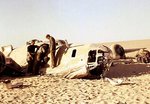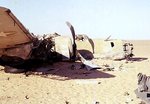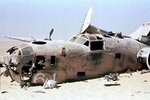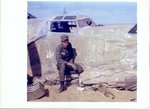ccheese
Member In Perpetuity
Lady Be Good was an American B-24D Liberator of the United States Army Air Forces, serial number 41-24301, during World War II. Based at Benina Airfield in Soluch (today Suluq), Libya, it crashed in April 1943 returning from a mission and was later discovered in 1959 hundreds of miles into the Sahara with its crew mysteriously missing.
Following an April 4, 1943 bombing raid on Naples, Italy, conducted by the 376th Bomb Group, the Lady Be Good of the 514th Bomb Squadron failed to return to base. After attempts to locate the plane in Libya, its nine crewmen were classified as Missing in action, and presumed dead, believed to have perished after crashing in the Mediterranean Sea.
The crew of Lady Be Good were on their first combat mission, having arrived in Libya on
March 18. The aircraft itself was also new, reaching the 376th BG on March 25. The ship had the identification number 64 painted on its nose and was one of 25 assigned to bomb Naples late in the afternoon of April 4.
The members of the Lady Be Good crew were:
1st Lt. William J. Hatton - pilot - Whitestone, New York
2nd Lt. Robert F. Toner - co-pilot - North Attleborough, Massachusetts
2d Lt. D.P. (initials only, also seen as "Dp") Hays - navigator - Lee's Summit, Missouri
2d Lt. John S. Woravka - bombardier - Cleveland, Ohio
T/Sgt. Harold J. Ripslinger - flight engineer - Saginaw, Michigan
T/Sgt. Robert E. LaMotte - radio operator - Lake Linden, Michigan
S/Sgt. Guy E. Shelley - gunner - New Cumberland, Pennsylvania
S/Sgt. Vernon L. Moore - gunner - New Boston, Ohio
S/Sgt. Samuel R. Adams - gunner - Eureka, Illinois
The crew took off from Benina shortly after 3:00 p.m., one of the last to depart. High winds and obscured visibility (and possibly the crew's inexperience[citation needed]) prevented it from joining the main formation of bombers, and it continued the mission on its own.
An 8:52 p.m. an entry in the navigator's log shows a bearing of 140° that indicates the plane abandoned the mission and turned back towards base, but its whereabouts at that time are not known and may have been a source of dispute among the crew itself[citation needed]. At approximately 10:00 p.m. the plane dropped its bombs into the Mediterranean to reduce weight and as a result fuel consumption.
At around midnight the pilot, Lt. Hatton, called base by radio and stated that his automatic direction finder was not working and asked for a location of base. He was apparently given a bearing but it is unknown if Lady Be Good received the transmission or not.
The plane apparently overflew its base and did not see flares fired to attract its attention and continued into the interior of North Africa for two more hours.
After the crew abandoned the aircraft, it continued flying southward. The mostly intact wreckage and evidence showing one engine was still operating at the time of impact suggests the aircraft gradually lost altitude in a very shallow descent, reached the flat, open desert floor and landed on its belly.
On February 27, 1959, British oil surveyor Paul Johnson spotted the wreckage near 26°42'45.7″N 24°01'27″E? / ?26.712694°N 24.02417°E? / 26.712694; 24.02417, 440 statute miles southeast of Soluch, following up a first sighting from the air on May 16, 1958, and another on June 15. A recovery team made initial trips from Wheelus Air Base to the crash site on May 26, 1959.
Although the plane was broken into two pieces, it was immaculately preserved, with functioning machine guns, a working radio, and some supplies of food and water. A thermos of tea was found to be drinkable. No human remains were found on board the aircraft, nor were parachutes found. Evidence aboard the plane indicated that the men had bailed out. Records in the log of navigator Lieutenant Hays, who was on his very first mission, ended at Naples.
The United States Army conducted a search for the remains of the airmen. Finding evidence the men had walked northward, the exploration concluded their bodies were buried beneath sand dunes.
In 1960, eight of the bodies were found by another British oil exploration team after an extensive ground search. After parachuting to the desert floor, eight of the nine airmen had managed to meet up by firing their revolvers and signal flares into the air. They had not been able to find the ninth crewman, bombardier John Woravka, because his parachute had only partially opened and he likely died on impact (his body was the first found in 1960). Thinking they were fairly close to the Mediterranean coast, the eight surviving crew members walked north, leaving behind footwear, parachute scraps, Mae West vests and other items as markers to show searchers what their path had been. They survived for eight days, sharing only a single canteen of water while walking over 100 miles (160 km) in searing heat before perishing. Remains of five airmen were found in a group nearly 80 miles (130 km) from the crash site. The other three (Guy Shelley, 'Rip' Ripslinger and Vernon Moore) had set off to try and find help while the other five waited behind. The bodies of Shelley and Ripslinger were found twenty and twenty-seven miles further north, respectively. Moore's remains were never found, although it is possible that seven years earlier in 1953 they had been spotted and buried by a British desert patrol, unaware that any air crews from the war had ever gone missing in the area.
A diary recovered from the pocket of co-pilot Robert Toner told of much suffering on the walk northward and indicated the crew were unaware they were over land when they bailed out. There has been speculation that whatever glimpses they may have caught of the empty desert floor in the darkness looked like open sea. It seems the crew never understood they were more than 400 miles (640 km) inland.
There is some consensus the crew could have survived had they known how far inland they were and moreover, if their maps shown the area where they bailed out. Going north, the distance they walked was slightly less than the distance needed to reach the oasis of El Zighen south of them, but they were wholly unaware of this. Additionally, if they headed south they would have very likely found the wreckage of the Lady Be Good with its water and food supplies, however meager, along with its working radio, which they might have used to call for help.
According to the Graves Registration Service report on the incident:
The aircraft flew on a 150 degree course toward Benina Airfield. The craft radioed for a directional reading from the HF/DF station at Benina and received a reading of 330 degrees from Benina. The actions of the pilot in flying 440 miles into the desert, however, indicate the navigator probably took a reciprocal reading off the back of the radio directional loop antenna from a position beyond and south of Benina but 'on course'. The pilot flew into the desert, thinking he was still over the Mediterranean and on his way to Benina.
Parts of the plane were scavenged or returned to the United States for evaluation. Curiously, several aircraft that were repaired with parts scavenged from the Lady Be Good crashed. An Army 'Otter' that had an armrest from the bomber crashed in the Gulf of Sidra. The only traces that were ever found from the plane were a few parts that washed ashore—including the armrest from the Lady Be Good.
Aside from components reused in other aircraft, other parts from the Lady Be Good may be seen today at the National Museum of the United States Air Force. One propeller can be seen in front of the village hall in Lake Linden, the home of Robert E. LaMotte.
A Royal Air Force team visited the site in 1968, and hauled away components including an engine (later donated to the USAF) for evaluation by the McDonnell Douglas company. Other pieces were stripped by souvenir hunters over the years.
In August 1994, the remains of the craft were recovered by a team led by Dr. Fadel Ali Mohammed and taken to a military base in Tobruk for safekeeping. [Source: Wiki]
I have followed the story very closley. From all accounts, the reason the plane and crew were lost is:
the aircraft did not have a functioning navigator. The History Channel has done a complete [but
somewhat in-accurate] story of the Lady Be Good.
About a year ago Roger Landry, who was an airman in the USAF, contacted me because he had found out
I was stationed at Wheelus AFB, in Tripoli, Libya. I was there 1953-1954 on exchange duty with the USAF.
The wreckage was discovered in 1959. Roger Landry sent me four pictures that he had taken of the wreck
site. In one of the pictures Roger Landry is standing by the nose of the plane, and you can actually see
the word "Good".
All photos courtesy of Roger Landry
Charles
Following an April 4, 1943 bombing raid on Naples, Italy, conducted by the 376th Bomb Group, the Lady Be Good of the 514th Bomb Squadron failed to return to base. After attempts to locate the plane in Libya, its nine crewmen were classified as Missing in action, and presumed dead, believed to have perished after crashing in the Mediterranean Sea.
The crew of Lady Be Good were on their first combat mission, having arrived in Libya on
March 18. The aircraft itself was also new, reaching the 376th BG on March 25. The ship had the identification number 64 painted on its nose and was one of 25 assigned to bomb Naples late in the afternoon of April 4.
The members of the Lady Be Good crew were:
1st Lt. William J. Hatton - pilot - Whitestone, New York
2nd Lt. Robert F. Toner - co-pilot - North Attleborough, Massachusetts
2d Lt. D.P. (initials only, also seen as "Dp") Hays - navigator - Lee's Summit, Missouri
2d Lt. John S. Woravka - bombardier - Cleveland, Ohio
T/Sgt. Harold J. Ripslinger - flight engineer - Saginaw, Michigan
T/Sgt. Robert E. LaMotte - radio operator - Lake Linden, Michigan
S/Sgt. Guy E. Shelley - gunner - New Cumberland, Pennsylvania
S/Sgt. Vernon L. Moore - gunner - New Boston, Ohio
S/Sgt. Samuel R. Adams - gunner - Eureka, Illinois
The crew took off from Benina shortly after 3:00 p.m., one of the last to depart. High winds and obscured visibility (and possibly the crew's inexperience[citation needed]) prevented it from joining the main formation of bombers, and it continued the mission on its own.
An 8:52 p.m. an entry in the navigator's log shows a bearing of 140° that indicates the plane abandoned the mission and turned back towards base, but its whereabouts at that time are not known and may have been a source of dispute among the crew itself[citation needed]. At approximately 10:00 p.m. the plane dropped its bombs into the Mediterranean to reduce weight and as a result fuel consumption.
At around midnight the pilot, Lt. Hatton, called base by radio and stated that his automatic direction finder was not working and asked for a location of base. He was apparently given a bearing but it is unknown if Lady Be Good received the transmission or not.
The plane apparently overflew its base and did not see flares fired to attract its attention and continued into the interior of North Africa for two more hours.
After the crew abandoned the aircraft, it continued flying southward. The mostly intact wreckage and evidence showing one engine was still operating at the time of impact suggests the aircraft gradually lost altitude in a very shallow descent, reached the flat, open desert floor and landed on its belly.
On February 27, 1959, British oil surveyor Paul Johnson spotted the wreckage near 26°42'45.7″N 24°01'27″E? / ?26.712694°N 24.02417°E? / 26.712694; 24.02417, 440 statute miles southeast of Soluch, following up a first sighting from the air on May 16, 1958, and another on June 15. A recovery team made initial trips from Wheelus Air Base to the crash site on May 26, 1959.
Although the plane was broken into two pieces, it was immaculately preserved, with functioning machine guns, a working radio, and some supplies of food and water. A thermos of tea was found to be drinkable. No human remains were found on board the aircraft, nor were parachutes found. Evidence aboard the plane indicated that the men had bailed out. Records in the log of navigator Lieutenant Hays, who was on his very first mission, ended at Naples.
The United States Army conducted a search for the remains of the airmen. Finding evidence the men had walked northward, the exploration concluded their bodies were buried beneath sand dunes.
In 1960, eight of the bodies were found by another British oil exploration team after an extensive ground search. After parachuting to the desert floor, eight of the nine airmen had managed to meet up by firing their revolvers and signal flares into the air. They had not been able to find the ninth crewman, bombardier John Woravka, because his parachute had only partially opened and he likely died on impact (his body was the first found in 1960). Thinking they were fairly close to the Mediterranean coast, the eight surviving crew members walked north, leaving behind footwear, parachute scraps, Mae West vests and other items as markers to show searchers what their path had been. They survived for eight days, sharing only a single canteen of water while walking over 100 miles (160 km) in searing heat before perishing. Remains of five airmen were found in a group nearly 80 miles (130 km) from the crash site. The other three (Guy Shelley, 'Rip' Ripslinger and Vernon Moore) had set off to try and find help while the other five waited behind. The bodies of Shelley and Ripslinger were found twenty and twenty-seven miles further north, respectively. Moore's remains were never found, although it is possible that seven years earlier in 1953 they had been spotted and buried by a British desert patrol, unaware that any air crews from the war had ever gone missing in the area.
A diary recovered from the pocket of co-pilot Robert Toner told of much suffering on the walk northward and indicated the crew were unaware they were over land when they bailed out. There has been speculation that whatever glimpses they may have caught of the empty desert floor in the darkness looked like open sea. It seems the crew never understood they were more than 400 miles (640 km) inland.
There is some consensus the crew could have survived had they known how far inland they were and moreover, if their maps shown the area where they bailed out. Going north, the distance they walked was slightly less than the distance needed to reach the oasis of El Zighen south of them, but they were wholly unaware of this. Additionally, if they headed south they would have very likely found the wreckage of the Lady Be Good with its water and food supplies, however meager, along with its working radio, which they might have used to call for help.
According to the Graves Registration Service report on the incident:
The aircraft flew on a 150 degree course toward Benina Airfield. The craft radioed for a directional reading from the HF/DF station at Benina and received a reading of 330 degrees from Benina. The actions of the pilot in flying 440 miles into the desert, however, indicate the navigator probably took a reciprocal reading off the back of the radio directional loop antenna from a position beyond and south of Benina but 'on course'. The pilot flew into the desert, thinking he was still over the Mediterranean and on his way to Benina.
Parts of the plane were scavenged or returned to the United States for evaluation. Curiously, several aircraft that were repaired with parts scavenged from the Lady Be Good crashed. An Army 'Otter' that had an armrest from the bomber crashed in the Gulf of Sidra. The only traces that were ever found from the plane were a few parts that washed ashore—including the armrest from the Lady Be Good.
Aside from components reused in other aircraft, other parts from the Lady Be Good may be seen today at the National Museum of the United States Air Force. One propeller can be seen in front of the village hall in Lake Linden, the home of Robert E. LaMotte.
A Royal Air Force team visited the site in 1968, and hauled away components including an engine (later donated to the USAF) for evaluation by the McDonnell Douglas company. Other pieces were stripped by souvenir hunters over the years.
In August 1994, the remains of the craft were recovered by a team led by Dr. Fadel Ali Mohammed and taken to a military base in Tobruk for safekeeping. [Source: Wiki]
I have followed the story very closley. From all accounts, the reason the plane and crew were lost is:
the aircraft did not have a functioning navigator. The History Channel has done a complete [but
somewhat in-accurate] story of the Lady Be Good.
About a year ago Roger Landry, who was an airman in the USAF, contacted me because he had found out
I was stationed at Wheelus AFB, in Tripoli, Libya. I was there 1953-1954 on exchange duty with the USAF.
The wreckage was discovered in 1959. Roger Landry sent me four pictures that he had taken of the wreck
site. In one of the pictures Roger Landry is standing by the nose of the plane, and you can actually see
the word "Good".
All photos courtesy of Roger Landry
Charles






